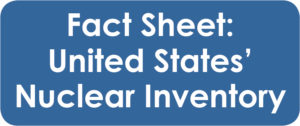 The United States was the first country to test an atomic bomb, with the Trinity test taking place in July 1945. It is also the only nation to use nuclear weapons in a conflict, dropping atomic bombs on Hiroshima and Nagasaki. From 1945 to 1992, the United States conducted 1,032 nuclear tests, most of which occurred underground after the Limited Test Ban Treaty was signed in 1963. The United States signed and ratified the Nuclear Non-Proliferation Treaty in 1968. In doing so, the nation agreed to pursue negotiations and reductions in good faith, with the eventual goal of complete nuclear disarmament.
The United States was the first country to test an atomic bomb, with the Trinity test taking place in July 1945. It is also the only nation to use nuclear weapons in a conflict, dropping atomic bombs on Hiroshima and Nagasaki. From 1945 to 1992, the United States conducted 1,032 nuclear tests, most of which occurred underground after the Limited Test Ban Treaty was signed in 1963. The United States signed and ratified the Nuclear Non-Proliferation Treaty in 1968. In doing so, the nation agreed to pursue negotiations and reductions in good faith, with the eventual goal of complete nuclear disarmament.
At its peak, the United States had more than 31,000 nuclear weapons in its stockpile. Through various arms control agreements and unilateral reductions, the United States has reduced this to its current nuclear inventory of 5,244 nuclear warheads, with around 3,708 active warheads in the stockpile and 1,536 retired warheads awaiting dismantlement. These weapons are deployed on air, sea, and land platforms in what is referred to as “The Nuclear Triad.” The United States currently plans to spend up to $1.5 trillion to overhaul its nuclear arsenal by rebuilding each leg of the triad and its accompanying infrastructure.
Under the Trump administration, many new nuclear weapons programs were proposed and modernization was largely pushed ahead of schedule while critical arms control and non-proliferation agreements like the Intermediate-Range Nuclear Forces (INF) Treaty, Open Skies Treaty, and the Iran nuclear deal were abandoned.
In February 2021, the United States and Russia agreed to a five-year extension of the New START treaty, capping each country’s arsenal at 1,550 nuclear warheads on 700 deployed delivery systems with 18 on-site inspections each year. The United States determined that Russia was not in compliance with the treaty in January 2023. A State Department Spokesperson explained, “Russia’s refusal to facilitate inspection activities prevents the United States from exercising important rights under the treaty and threatens the viability of US-Russian nuclear arms control,” as in August 2022, the Kremlin blocked treaty-bound inspections visits to its facilities and in November 2022, Moscow postponed the treaty’s bilateral consultative commission. Russian President Vladimir Putin declared in late February 2023 that Russia was “suspending” its participation in New START. President Joe Biden has still pledged to work with allies in pursuing a new era of arms control and diplomatic negotiations with countries such as Russia, Iran and North Korea.
Recent Analysis on the United States
- Op-ed: Californians must step up pressure to ensure a full cleanup of toxic Santa Susana lab October 21, 2024
- Comparative Summary: Fiscal Year 2025 National Defense Authorization Act September 12, 2024
- Heatwaves and H-Bombs: The Nuclear Triad’s Vulnerabilities to Climate Change August 27, 2024
- Op-ed: Why Congress Shouldn’t Fund a New Sea-Launched Nuke August 15, 2024
- We Now Know the Full Extent of the U.S. Nuclear Arsenal August 6, 2024
- Summary: Fiscal Year 2025 National Defense Authorization Act (S. 4638) as passed by the Senate Committee on Armed Services July 16, 2024
- The Elimination of U.S. Chemical Weapons: Lessons Learned and Future Prospects July 12, 2024
- Where Is the Protest? June 24, 2024
- What If There Were No Diplomatic Solution? June 7, 2024
- Op-Ed: Where’s the Accountability? Congress Must Get Answers Before Spending More on Missile Program June 5, 2024

